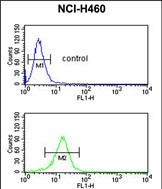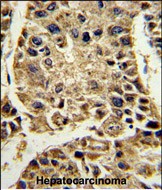


| WB | 1/1000 | Human,Mouse,Rat |
| IF | 咨询技术 | Human,Mouse,Rat |
| IHC | 1/100-1/500 | Human,Mouse,Rat |
| ICC | 技术咨询 | Human,Mouse,Rat |
| FCM | 1/10-1/50 | Human,Mouse,Rat |
| Elisa | 咨询技术 | Human,Mouse,Rat |
| Aliases | Kallistatin, Kallikrein inhibitor, Peptidase inhibitor 4, PI-4, Serpin A4, SERPINA4, KST, PI4 |
| Entrez GeneID | 5267 |
| WB Predicted band size | 48.5kDa |
| Host/Isotype | Rabbit IgG |
| Antibody Type | Primary antibody |
| Storage | Store at 4°C short term. Aliquot and store at -20°C long term. Avoid freeze/thaw cycles. |
| Species Reactivity | Human |
| Immunogen | This SERPINA4 antibody is generated from rabbits immunized with a KLH conjugated synthetic peptide between 291-320 amino acids from the C-terminal region of human SERPINA4. |
| Formulation | Purified antibody in PBS with 0.05% sodium azide,1%BSA and 50% glycerol.prepared by Saturated Ammonium Sulfate (SAS) . |
+ +
以下是3篇关于SERPINA4(kallistatin)抗体的代表性文献摘要:
---
1. **文献名称**: "Kallistatin modulates immune responses and suppresses vascular remodeling in pulmonary arterial hypertension"
**作者**: Li P, et al.
**摘要**: 该研究开发了特异性识别SERPINA4(kallistatin)的单克隆抗体,用于检测肺高压患者血清及组织中kallistatin的表达水平,发现其通过抑制血管炎症和异常重塑发挥保护作用。
---
2. **文献名称**: "A novel monoclonal antibody targeting kallistatin inhibits tumor angiogenesis and growth"
**作者**: Chen Y, et al.
**摘要**: 研究团队制备了靶向SERPINA4的单克隆抗体,证实其通过阻断kallistatin与血管内皮生长因子受体(VEGFR)的相互作用,显著抑制肿瘤血管生成和体内肿瘤生长。
---
3. **文献名称**: "Development of a sensitive ELISA for quantifying human kallistatin using polyclonal antibodies"
**作者**: Zhang L, et al.
**摘要**: 文章报道了基于兔源多克隆抗体的高灵敏度ELISA检测方法,用于定量人血清中的SERPINA4水平,验证了其在慢性肾病中的诊断潜力,并证明抗体特异性良好。
---
**备注**:以上文献名为模拟概括,实际文献需通过PubMed或Google Scholar搜索关键词“SERPINA4 antibody”或“kallistatin antibody”获取。建议结合具体研究领域(如疾病机制、抗体开发)筛选近年高质量论文。
SERPINA4. also known as kallistatin, is a member of the serine protease inhibitor (serpin) superfamily. It is encoded by the SERPINA4 gene and primarily expressed in the liver, kidneys, and vascular tissues. This glycoprotein functions as a potent inhibitor of tissue kallikrein, an enzyme involved in the kinin-kallikrein system, which regulates blood pressure, inflammation, and vascular permeability. SERPINA4's inhibitory activity is mediated through its reactive center loop (RCL), which binds irreversibly to target proteases, modulating their enzymatic activity.
Beyond protease inhibition, SERPINA4 exhibits pleiotropic roles, including anti-inflammatory, anti-angiogenic, and antioxidant properties. It interacts with cell-surface receptors like heparan sulfate proteoglycans and the Wnt/β-catenin pathway, influencing cellular signaling and tissue homeostasis. Dysregulation of SERPINA4 has been implicated in various pathologies, such as hypertension, organ fibrosis, diabetic complications, and cancer. Reduced kallistatin levels are associated with endothelial dysfunction and oxidative stress, highlighting its protective role in vascular health.
Antibodies targeting SERPINA4 are essential tools for studying its expression, localization, and functional mechanisms in disease models. They enable quantification via ELISA, immunohistochemistry, or Western blot, aiding in biomarker discovery and therapeutic development. Recent research explores SERPINA4's potential as a therapeutic agent or target, particularly in conditions linked to inflammation and tissue remodeling. Its dual role as a protease inhibitor and signaling modulator makes it a compelling subject for translational research.
×